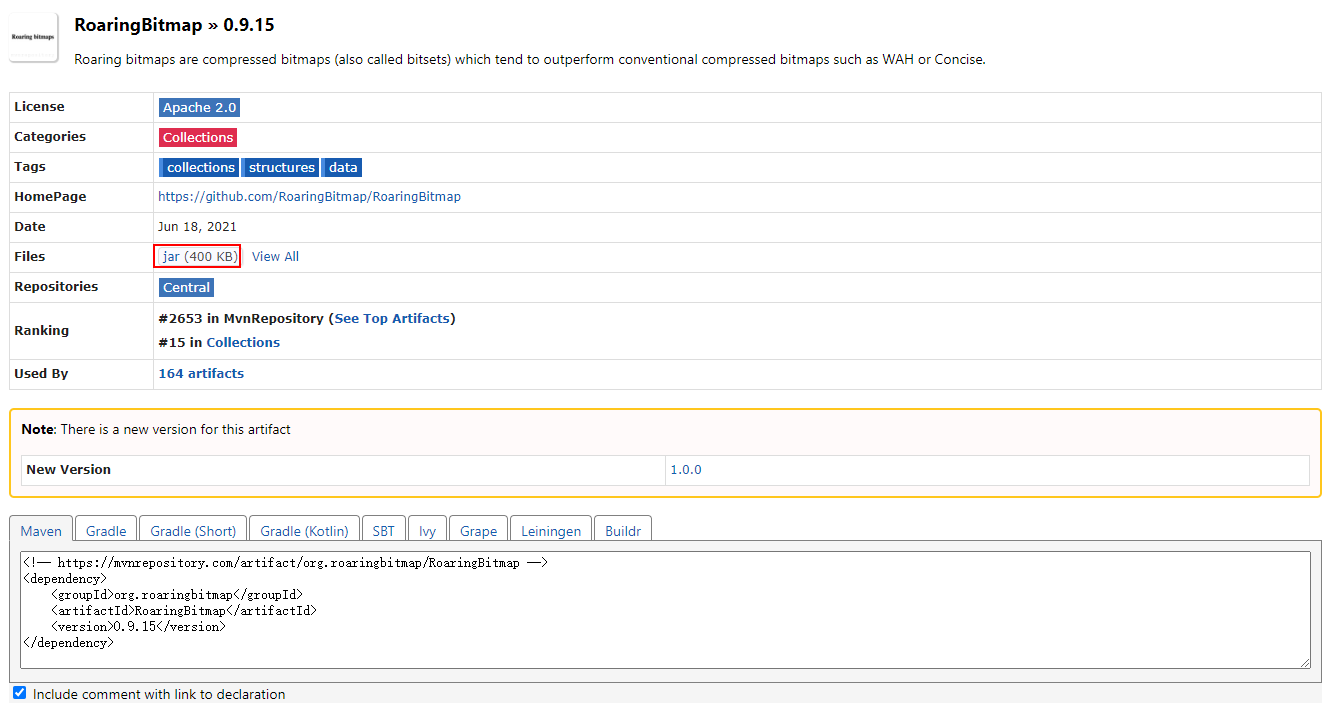Example: Processing the RoaringBitmap Result Set on Application Then Importing It to GaussDB(DWS)
GaussDB(DWS) 8.1.3 and later versions support the RoaringBitmap function. When using the Java language to perform secondary development based on GaussDB(DWS), you can use the CopyManager interface to import a small amount of RoaringBitmap data to GaussDB(DWS).

To import a large amount of RoaringBitmap data, computing power of the application side needs to be increased. Otherwise, the import performance will be affected.
Processing RoaringBitmap Data
- Visit Maven to download the open-source RoaringBitmap JAR package. Version 0.9.15 is recommended.
The dependency items of the POM file are configured as follows:
1 2 3 4 5 6 7
<dependencies> <dependency> <groupId>org.roaringbitmap</groupId> <artifactId>RoaringBitmap</artifactId> <version>0.9.15</version> </dependency> </dependencies>

- Invoke the JAR package to convert data to the RoaringBitmap type.
The general process is to declare a Roaring bitmap, call the add() method to convert data of the int type into the Roaringbitmap type, and then serialize the converted data. The sample code is as follows:
1 2 3 4 5 6 7
RoaringBitmap rr2 = new RoaringBitmap (); for (int i = 1; i < 10000000; i++) { rr2.add(i); } ByteArrayOutputStream a = new ByteArrayOutputStream(); DataOutputStream b = new DataOutputStream(a); rr2.serialize(b);
Data Import
Invoke CopyManager to import data to the database. In this way, a small amount of RoaringBitmap data can be imported to the database without having to be stored locally.
1 2 3 4 5 6 7 8 9 10 11 12 13 14 15 16 17 18 19 20 21 22 23 24 25 26 27 28 29 30 31 32 33 34 35 36 37 38 39 40 41 42 43 44 45 46 47 48 49 50 51 52 53 54 55 56 57 58 59 60 61 62 63 64 65 66 67 68 69 70 71 72 73 74 75 76 77 78 79 80 81 82 83 84 85 86 87 88 89 90 91 92 93 94 95 96 97 98 99 100 101 102 103 104 105 106 107 108 109 110 111 112 113 |
//gsjdbc4.jar is used as an example. If gsjdbc200.jar is used, replace the driver class name org.postgresql with com.huawei.gauss200.jdbc and replace the URL prefix jdbc:postgresql with jdbc:gaussdb. package rb_demo; import org.postgresql.copy.CopyManager; import org.postgresql.core.BaseConnection; import org.roaringbitmap.RoaringBitmap; import java.io.ByteArrayInputStream; import java.io.ByteArrayOutputStream; import java.io.DataOutputStream; import java.io.IOException; import java.io.InputStream; import java.io.StringReader; import java.sql.Connection; import java.sql.DriverManager; import java.sql.PreparedStatement; import java.sql.ResultSet; import java.sql.SQLException; import java.sql.Statement; public class rb_demo { private static String hexStr = "0123456789ABCDEF"; public static String bytesToHex(byte[] bytes) { StringBuffer sb = new StringBuffer(); for (int i = 0; i < bytes.length; i++) { String hex = Integer.toHexString(bytes[i] & 0xFF); if (hex.length() < 2) { sb.append(0); } sb.append(hex); } return sb.toString(); } public static Connection GetConnection(String username, String passwd) { String driver = "org.postgresql.Driver"; String sourceURL = "jdbc:postgresql://10.185.180.161: 8000/gaussdb"; //Database URL Connection conn = null; try { //Load the database driver. Class.forName(driver).newInstance(); } catch (Exception e) { e.printStackTrace(); return null; } try { //Establish a connection to the database. conn = DriverManager.getConnection(sourceURL, username, passwd); System.out.println("Connection succeed!"); } catch (Exception e) { e.printStackTrace(); return null; } return conn; } public static void main(String[] args) throws IOException { RoaringBitmap rr2 = new RoaringBitmap(); for (int i = 1; i < 10000000; i++) { rr2.add(i); } ByteArrayOutputStream a = new ByteArrayOutputStream(); DataOutputStream b = new DataOutputStream(a); rr2.serialize(b); Connection conn = GetConnection("test", "Gauss_234"); //User name and password. Statement pstmt = null; try { conn.setAutoCommit(true); pstmt = conn.createStatement(); pstmt.execute("drop table if exists t_rb"); pstmt.execute("create table t_rb(c1 int, c2 roaringbitmap) distribute by hash (c1);"); StringReader sr = null; CopyManager cm = null; cm = new CopyManager((BaseConnection) conn); String delimiter = "|"; StringBuffer tuples = new StringBuffer(); tuples.append("1" + delimiter + "\\x" + bytesToHex(a.toByteArray())); StringBuffer sb = new StringBuffer(); sb.append(tuples.toString()); sr = new StringReader(tuples.toString()); String sql = "copy t_rb from STDIN with (delimiter '|', NOESCAPING)"; long rows = cm.copyIn(sql, sr);//Execute the COPY command to save data to the database. pstmt.close(); } catch (SQLException e) { if (pstmt != null) { try { pstmt.close(); } catch (SQLException e1) { e1.printStackTrace(); } } e.printStackTrace(); } } } |
Feedback
Was this page helpful?
Provide feedbackThank you very much for your feedback. We will continue working to improve the documentation.See the reply and handling status in My Cloud VOC.
For any further questions, feel free to contact us through the chatbot.
Chatbot





